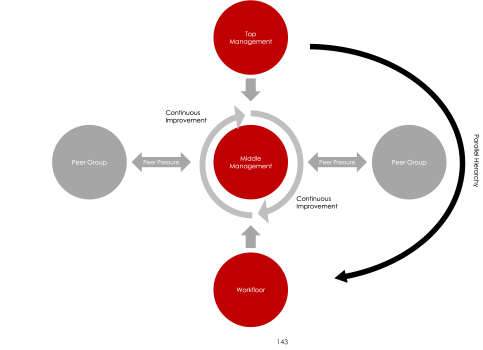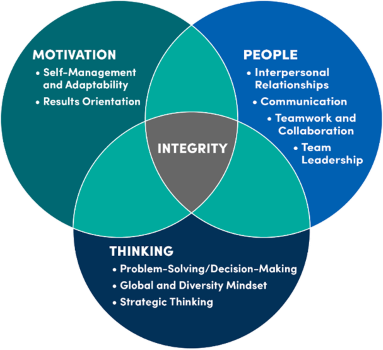Middle management in agile transformation
How many times have you heard the line ‘There are no managers in Agile!’ If you look at most of the frameworks out there, middle managers are not a key focus area. But why?
Let’s look at the real world. Who is a middle manager? According to the Chartered Management Institute, middle managers are the ‘lifeblood of an organisation, serving as key communicators, connectors and, crucially, trust builders’ (Rock, 2017).
Consistent communication underpins success.
This is where Middle management really influence the success or failure of a transformation. They have the ear of those leading the change from a strategic perspective and those who must adopt this new approach for the transformation to succeed and the realised benefits. Their ability and position to communicate across the hierarchy of the business places them in the ideal position to disseminate a consistent message from leadership, while also enabling them to drive home the desired outcomes.

(Middle Management.eun n.d)
A fundamental shift in mindset
A shift from what is perceived to be traditional management to a leadership mindset is required for middle managers to succeed. Traditional management embodies a project led, narrow focused, detail-oriented, and organised mindset. Leadership on the other hand is visionary, adapting management styles in a way that enables them to go above and beyond and inspire their teams.
An effective tool that can be used in this transition is Watkins' Seven Seismic Shifts. Although originally aimed at managers moving from leading a function to leading an enterprise, these same principles apply for managers moving to a leadership-oriented role.

(Buffalo University, n.d)
Empowering others through Leadership
The agile frameworks advocate empowerment but give little indication on how this can be achieved. Empowerment is something people need to feel, rather than something we are told. The manager plays a critical role in creating an environment where team members feel safe, making decisions about their work, within the given parameters without fear of recrimination.
The benefit of an empowered culture is evident in areas such as employee retention, customer satisfaction and increased productivity (Grass, 2020). To create an empowered team, middle managers must put their empathy hats on, as this is crucial to success.
For leaders, this means taking the focus away from performance and output and shifting to individuals and how they feel, and cope in business.
While considering empowerment, it is also important to think about achieving autonomy. Empowerment is externally driven, while autonomy is individual – a feeling that we have the authority to make our own decisions. Crucial to the success of transitioning middle management is the ability to balance autonomy and empowerment for those in their charge.
A shift in decision making
Traditionally, decision making sits with managers, often overloading them. A report by Gallup highlights that managers are 50% more likely have too much work to do" (O'Keefe, 2020). Decentralising decision-making has several benefits, it allows managers to focus on the work they must do. pushing decision making downwards empowers teams to leverage their collective skills, experiences, and capabilities to create innovative solutions, with shortened feedback loops, driving the delivery of better products to customers.
in decision-making power can create a feeling of anxiety and vulnerability as perceived control is eroded. With more at stake (jobs, culture change etc.), people can proactively turn against such change, and sometimes go out of their way to derail projects.
Managers influence 70% of their team engagement, making them a critical influence to change (O'Keefe, 2020). We recommend at the beginning of your agile transformation, invest time and energy with middle managers. Focus on their mindset, visualising the evolution of their roles from management of the job to the leadership and inspiration of the people within their charge.
A ‘layered’, holistic transformation approach supports success. Show middle managers what good looks like and how it will benefit them. Become the trusted advisor and work with them to introduce new ideas and ways of working to their staff. Per Kotters Change Principles, this group of people will then ‘build your guiding coalition’ driving the transformation forward.
Finally, remember Middle managers are employees too and understand that they need coaching through this change process.
Authored by:
Cherukei Orianwo- Agility Coach
Peter Tumilson- Agility Coach
Tim Stares- Delivery Manager
References
Buffalo University, n.d. LeaderCore Competencies Model. s.l.:s.n.
Christodoulou, W. R. I., 19 October 2022. The strategic role of middle managers in the formulation and implementation of digital transformation projects. s.l.:s.n.
Grass, B. H., 2020. From Empowerment Dynamics to Team Adaptability: Exploring and Conceptualizing the Continuous Agile Team Innovation Process. s.l.:Wiley Periodicals LLC on behalf of Product Development & Management Association.
Middle Management.eu, n.d. The role of middle management in achieving continuous improvement: a demanding plaing field. s.l.:s.n.
O'Keefe, S. M., 2020. 4 Ways to Help Managers Handle Heavy Workloads. s.l.:Gallup.
Rock, S., 2017. Eight Reasons Why You Should Love Your Middle Managers. s.l.:Chartered Management Institute.
